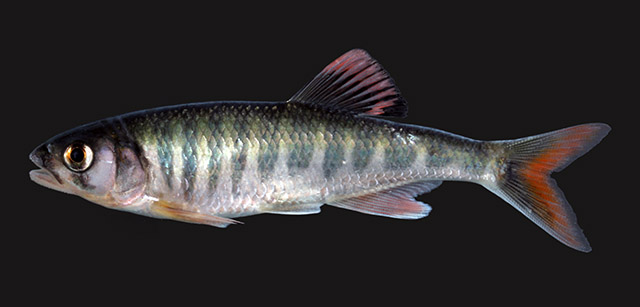| Danionidae (Danios), subfamily: Chedrinae |
| 12 cm TL (male/unsexed) |
|
benthopelagic; freshwater |
| Africa: widespread in coastal basins from Cameroon to the Republic of Congo (Ref. 81639). Also in upper tributaries of Lake Chad and Benue River systems (Ref. 51193). Present in the middle (Ref. 26673, 41590, 41594, 45434, 45441, 46861) and upper (Ref. 27609, 45434, 93587) Congo River basin, in the Lukuga up to the Lukuga-Niemba confluence (Ref. 93587). |
|
Dorsal spines (total): 0-0; Dorsal soft rays (total): 10-12; Anal spines: 0-0; Anal soft rays: 14-17. Diagnosis: 7.0-8.5 scales between lateral line and dorsal fin origin; 39-44 scales in lateral line; 3-5.5 scales between lateral line and mid-belly; 2 scales between lateral line and pelvic fin base; 14-16 circumpeduncular scales; 8-12 dark, vertical bars on sides; dorsal fin darkly pigmentated between the rays (Ref. 81639).
Description: mouth terminal, without barbels; scales with divergent striae; dorsal fin originates in advance of the anal; D: II-III,8-9; A: III, 11-14; P:14-15; V: I,8; caudal fin forked (Ref. 81639).
Coloration: body olive-brown dorsally, silvery on flanks and ventrum; 8-12 dark, vertical bars, often in pairs, along the flanks; dorsal fin with dark pigmentation between the rays (Ref. 81639). |
|
|
Least Concern (LC); Date assessed: 28 August 2019 Ref. (130435)
|
| harmless |
|
Source and more info: www.fishbase.org. For personal, classroom, and other internal use only. Not for publication.

